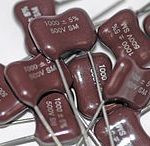Chemically, micas can be given the general formula[6]
in which
X is K, Na, or Ca or less commonly Ba, Rb, or Cs;
Y is Al, Mg, or Fe or less commonly Mn, Cr, Ti, Li, etc.;
Z is chiefly Si or Al, but also may include Fe3+ or Ti.
Structurally, micas can be classed as dioctahedral (Y = 4) and trioctahedral (Y = 6). If the X ion is K or Na, the mica is a common mica, whereas if the X ion is Ca, the mica is classed as a brittle mica.




